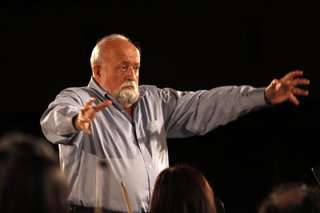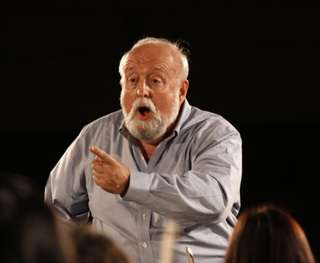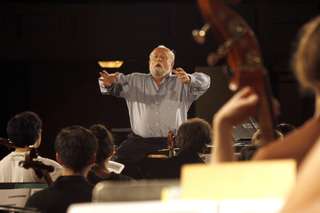|
Back
Thoughts of a Titan New York
Stern Auditorium, Carnegie Hall
04/30/2010 -
Yale School of Music and Yale in New York present “Penderecki Conducts Penderecki”
Krzysztof Penderecki: Threnody to the Victims of Hiroshima (1960) – Capriccio for Violin and Orchestra (1967) – Concerto for Horn and Orchestra, “Winterreise” (2008) – Symphony No. 4, “Adagio” (1989)
Syoko Aki (Violin), William Purvis (Horn)
Philharmonia Orchestra of Yale, Krzysztof Penderecki (Conductor)

K. Penderecki (© Vincent Oneppo)
The ecstatic experience I had with my initial discovery of Krzysztof Penderecki has never left me. Toward the end of the St. Luke Passion, the massed choruses and orchestra are playing about 14 different notes at once, as loudly as they can–and then, while we are wrapped up in that disconcerting bundle of chords, without a fraction of a space, the chorus abruptly sings about eight bars of archaic 13th or 14th Century music, before carrying on with the dissonances.
I say ecstatic, but it was a musical time-trip, leaving me shattered. This was hardly unusual, as I learned, since Mr. Penderecki explained that he searches for new sounds while studying the past eras.
“My current creative output is a synthesis,” he is quoted in the program notes for last night’s extraordinary concert.
In one way, the Yale School of Music all-Penderecki concert was shockingly disappointing. With the death of Messiaen and Lutoslawski, Krzysztof Penderecki is the last giant of European music. Yet Carnegie Hall was hardly filled. I had expected crowds outside clamoring for tickets to this most historic occasion. Yet perhaps 70 percent of the seats downstairs were filled.
Those of us who came were not disappointed. The 77-year-old Krakow-born artist is not simply prolific, but his music takes only the most serious subjects. How he treats these subjects is his business, but nothing is petty in his challenges.
(Except for one amazing fact I learned last night. His most famous work, Threnody to the Victims of Hisoshima, originally had no title and was unpublishable. With a new title, the Polish Government used it as an anti-American propaganda piece!)

K. Penderecki (© Vincent Oneppo)
Otherwise, these four works were everything one could want from Mr. Penderecki. Like his music, his conducting is singular. He rarely used both hands, using either hand for directing rhythm and dynamics. But one orchestral member told me his results came in the “very picky” rehearsals.
The four works gave four totally different pictures of the composer. Yes, the Threnody is well known, but to hear the large Yale Philharmonia string section essay those massive sounds was a revelation. Were these air-raid sirens told in textures note clusters and incessant glissandos? More than that, the strings have dozens of different special effects, different taps, claps, harmonics to give it the wall of sound which we think we know so well. Only by hearing it live can we hear what Mr. Penderecki imagined.
If the Threnody was a whole string orchestra grown wild, his Capriccio, written seven years later, showed one instrument gone totally manic. A colleague suggested that Syoko Aki, a member of Yale faculty, played this like the notes were like a shattered mirror. Correct–but oh, how 18th Century is a shattered mirror. Her notes were more like atoms smashed, the electrons and neutrinos flying in all directions at once
Unlike Hiroshima, though, nobody was hurt in the playing. And here we come to those strange time-trips of Mr. Penderecki. Suddenly we pick up a few measures of a waltz–or even more sensationally some kitschy oom-pahs in the timpani and basses. Mr. Penderecki doesn’t need a theremin, but his music at times had that theremin sound. Despite the innocent title, it could have been a parody of the usual violin concertos. Mr. Penderecki does have a sense of humor, if a grotesque humor!
(Yes, there was a reason why William Friedkin and Stanley Kubrick used his music in The Exorcist and The Shining respectively.)
Now, suddenly came the face of the past for the New York premiere of a horn concerto. The first few measures, with horns offstage, and a rising in cellos basses sounded familiar. This was like–with a few “wrong” notes–Richard Strauss’s Alpine Sympnony. Nor was it a trick. The entire piece, played with dramatic hunting calls by William Purvis (also on the Yale faculty), had harmonies of ordinary late 19th Century tonics and dominants. Difficult to imagine that it was written a few years ago.
The longest work was the Fourth Symphony, which began typically (if there is such a thing!) with the loudest possible sounds. A single-note trumpet fanfare, held for the three minutes, with basses and cellos running wild underneath the call. After this, Mr. Penderecki offered more tranquil moods, with several instruments repeating phrases over and over again. These worked into a sort of fugue. A fugue which stopped and started, where other orchestral timbres were like interlopers, as if they were stuck in to make certain a formal fugue could not be completed.
More essential, Mr. Penderecki here presented orchestral colors radiant and distorted. Great gongs, double-bass mantras, those glissandi forming a palette on which to pain more commanding sounds.

K. Penderecki & the Philharmonia Orchestra of Yale
(© Vincent Oneppo)
All four works came from the mind–or minds–of a giant. Neither the forces or the effects were modest. Mr. Penderecki is man whose textures are as massive and pictorial as an Uzbek carpet, but the pictures he paints could come from Hieronymus Bosch. Demonic, foreboding and in their entirety the gloriouis world-view of a living Colossus.
Harry Rolnick
|